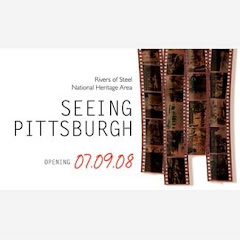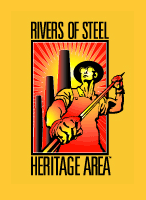"Seeing Pittsburgh" through foreign eyes
 New book helps answer one woman's questions about her adopted city
New book helps answer one woman's questions about her adopted city
by Silvia Duarte
When you are a foreigner, it doesn’t matter where you go, you are asked common questions. Where are you from? How long have you been here? What are you doing here? Questions that people from almost anyone around the world could ask.
After I came from Guatemala to Pittsburgh the questions were the same. But one of them surprised me until now. Bus drivers, academics, waiters, my English teachers, and other foreigners often ask: “Do you like Pittsburgh?” and not just once, many times.
Oh my God, what do you answer when you have had a bad day after only living here one week? What do you answer one month after if an employee – from Pittsburgh – of a fast food restaurant shouts at you because they can’t understand your “sort of English.” I like where I live, my neighbors, Downtown streets, the bridges, the parks, but how can I really know each neighborhood? How can I speak in general about the city when it has so many particulars?
What is a city if not the neighbors’ perceptions? And can I understand those perceptions if I’m not there?
Many times I thought that it would be nice to visit different neighborhoods, share with the people, discover what they think about Pittsburgh and, just after that, give my opinion.
Voila! Two weeks ago I was handed the book “Seeing Pittsburgh” that allowed me to visually explore corners of the city that I didn’t know. It also presented me faces and people’s perceptions, contemporaries like you and me.
The book is part of the Rivers of Steel National Heritage Area exhibit called "Seeing Pittsburgh." It also includes video and archival footage.
On one hand the book is a tribute to the celebration of Pittsburgh’s 250th anniversary yet is also a walk through 11 of the city’s 90 neighborhoods. The introduction explains its mission: “armed only with cameras – digital, film, disposable and even camera phone - and the instructions to show us what defines their neighborhood, 44 Pittsburghers became the Seeing Pittsburgh Project.”
A little more than a year ago, the editors – Ron Baraff and Tiffani Emig – contacted residents of different neighborhoods through community groups. Children and adults were chosen to shoot and summarize their photos in few words. The result? Magnificent pictures of the collective imagination.
Is it a risk that the neighbors just capture only the beautiful and hide the dirty clothes? Yes, it’s a risk. But who can say that perception about your surroundings is more than one invention of your experience and your personal belonging?
With “Seeing Pittsburgh” I walked through “my city” from east to west, from north to south. I looked at scenes that could belong to all the neighborhoods – which doesn’t have beautiful trees and squirrels that eat there. And others that show big differences – such as how to escape to the historical background of the North Side.
Do you want to know about some of the images that the Pittsburghers photographed? And how they describe their image? Let’s go neighborhood by neighborhood. In alphabetical order, like they appear in the book.
In Beechview, a girl who captured her school road wrote that her neighborhood “is a great place for families.” Another photographer there described Evelia, who works in Tienda La Jimenez, as making “the best tamales in all Pittsburgh.” Also, a boy laments because the swimming pool where he used to swim, “now all it is used for is graffiti.”
In Forest Hills, the “atom smasher” (a former Westinghouse facility) stands out against cottony sky and some mothers formed an informal club while they await their children’s’ buses.
The jazz flows out of the windows of an historical building on Centre Avenue in the Hill District. And while a man waits for the bus, a woman relaxes on her porch on a typical American evening. A couple of pages after, a group of teenagers transform a swing into a human banana split. The young photographer writes, “it’s a way to show our friendship as young people.”
In Lawrenceville, a neighbor remembers the stone streets of his childhood. Another neighbor attempts to take care of an abandoned next door while the fall comes to dress up the 40th Street Bridge.
Good music plus community life plus Ukrainians and Polish traditions -mass, priests and periogies- abound in Mckees Rocks.
The Mt. Lebanon's photographers chose to capture schools -Lincoln and Herbert Clark Hoover - traffic rush-hour at Washington Road, badly parked cars and a play area that the neighbors defend from construction machines.
Chatham Village was captured in full bloom: beautiful flowers, a sweet squirrel and a nice courtyard. The neighborhood’s “oldest resident” and children celebrating Independence Day show strong community spirit.
And then comes Central Northside, Dish's neighborhood, my neighborhood. Five photographers (Dish's Frank Kownacki among them) captured this diverse, polemic, nice, tranquil and sometimes dangerous place that I like so much. Maybe I'm wrong, but the Central Northside photographers stand out from the others thanks to their honesty. They found images and used blunt words even if some people might not like their point of shoot.
There is the beautiful Tabernacle Baptist Church and the man who describes himself as "hungry, ugly and broke.” He doesn't have a home, but he has dozens of streets and an entire world in his sleeping bag. Just two pages divide a house restoration from the teenager who spits her soul and says: "We like our neighborhood because it is pretty and fun. But it’s dangerous over here, people shoot.” Together are the girl at the children’s garden and the polemic corridor – the site of the Masonic Hall and the Garden Theater. There is the modern Mattress Factory and a vacant lot on Jacksonia Street. Contrast and beauty, that is Northside.
The book’s trip leads to Point Breeze and a stained glass artwork piece on the side of the Point Brugge Cafe restaurant. One page after is the Frick Museum and, at the end, the Frick park where “it’s almost like a peek into another world”.
The cameras’ lenses shoot South Side in the morning although for me it's difficult not to imagine its streets at night. While a priest captured his congregation, another photographer shows T&T;, one of the oldest hardware stores. The beautiful mural at the Terminal Building puts a nice period on the South Side visit.
The last neighborhood is Squirrel Hill. Between the images you can see the Big Blue Slide at the playground in Frick Park, “a central role in the childhoods (or adult hoods, as the case may be) of many Pittsburghers.” A colorful vegetable store, Forbes Avenue businesses and one of the oldest houses in the neighborhood finish our Pittsburgh view.
“Seeing Pittsburgh” offers a large slice of the city and its people. And when I leave here to return home I will bring back my own images of this city - the diaspora and the reunion, the strong feeling of neighborhood, garden grills, libraries, museums, amazing architecture, icee balls, people who say hello while they enjoy summer evenings in their stoops, corner stores, parks, farmers’ markets, concerts, people helping others, season changes, Strip District and fun.
Yes, folks, I like what I have seen of Pittsburgh!
For information on purchasing the book and seeing the exhibit go here. Read their bloghere.
Journalist Silvia Duarte was born in Guatemala and currently resides one block from Dish headquarters. Read her stories here and here.


